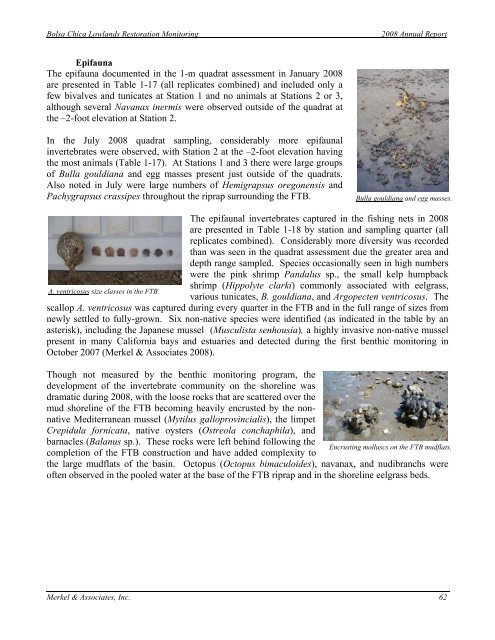2008 Annual Monitoring Report (pdf 10.9MB) - Bolsa Chica ...
2008 Annual Monitoring Report (pdf 10.9MB) - Bolsa Chica ...
2008 Annual Monitoring Report (pdf 10.9MB) - Bolsa Chica ...
You also want an ePaper? Increase the reach of your titles
YUMPU automatically turns print PDFs into web optimized ePapers that Google loves.
<strong>Bolsa</strong> <strong>Chica</strong> Lowlands Restoration <strong>Monitoring</strong><br />
<strong>2008</strong> <strong>Annual</strong> <strong>Report</strong><br />
Epifauna<br />
The epifauna documented in the 1-m quadrat assessment in January <strong>2008</strong><br />
are presented in Table 1-17 (all replicates combined) and included only a<br />
few bivalves and tunicates at Station 1 and no animals at Stations 2 or 3,<br />
although several Navanax inermis were observed outside of the quadrat at<br />
the –2-foot elevation at Station 2.<br />
In the July <strong>2008</strong> quadrat sampling, considerably more epifaunal<br />
invertebrates were observed, with Station 2 at the –2-foot elevation having<br />
the most animals (Table 1-17). At Stations 1 and 3 there were large groups<br />
of Bulla gouldiana and egg masses present just outside of the quadrats.<br />
Also noted in July were large numbers of Hemigrapsus oregonensis and<br />
Pachygrapsus crassipes throughout the riprap surrounding the FTB.<br />
Bulla gouldiana and egg masses.<br />
The epifaunal invertebrates captured in the fishing nets in <strong>2008</strong><br />
are presented in Table 1-18 by station and sampling quarter (all<br />
replicates combined). Considerably more diversity was recorded<br />
than was seen in the quadrat assessment due the greater area and<br />
depth range sampled. Species occasionally seen in high numbers<br />
were the pink shrimp Pandalus sp., the small kelp humpback<br />
shrimp (Hippolyte clarki) commonly associated with eelgrass,<br />
A. ventricosus size classes in the FTB.<br />
various tunicates, B. gouldiana, and Argopecten ventricosus. The<br />
scallop A. ventricosus was captured during every quarter in the FTB and in the full range of sizes from<br />
newly settled to fully-grown. Six non-native species were identified (as indicated in the table by an<br />
asterisk), including the Japanese mussel (Musculista senhousia), a highly invasive non-native mussel<br />
present in many California bays and estuaries and detected during the first benthic monitoring in<br />
October 2007 (Merkel & Associates <strong>2008</strong>).<br />
Though not measured by the benthic monitoring program, the<br />
development of the invertebrate community on the shoreline was<br />
dramatic during <strong>2008</strong>, with the loose rocks that are scattered over the<br />
mud shoreline of the FTB becoming heavily encrusted by the nonnative<br />
Mediterranean mussel (Mytilus galloprovincialis), the limpet<br />
Crepidula fornicata, native oysters (Ostreola conchaphila), and<br />
barnacles (Balanus sp.). These rocks were left behind following the<br />
completion of the FTB construction and have added complexity to<br />
the large mudflats of the basin. Octopus (Octopus bimaculoides), navanax, and nudibranchs were<br />
often observed in the pooled water at the base of the FTB riprap and in the shoreline eelgrass beds.<br />
Encrusting molluscs on the FTB mudflats.<br />
Merkel & Associates, Inc. 62






